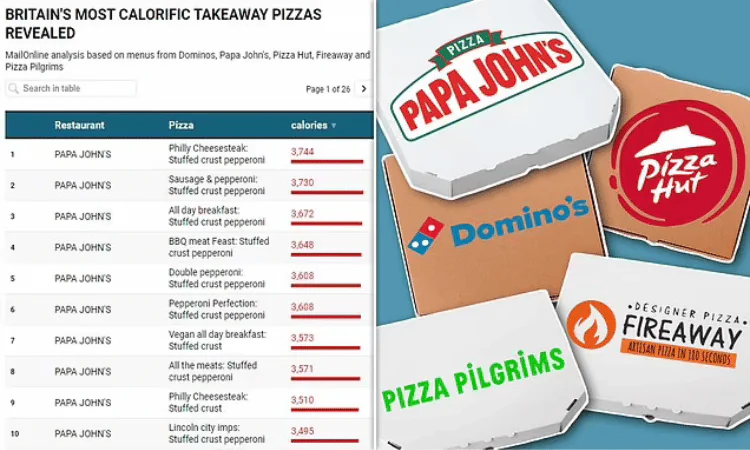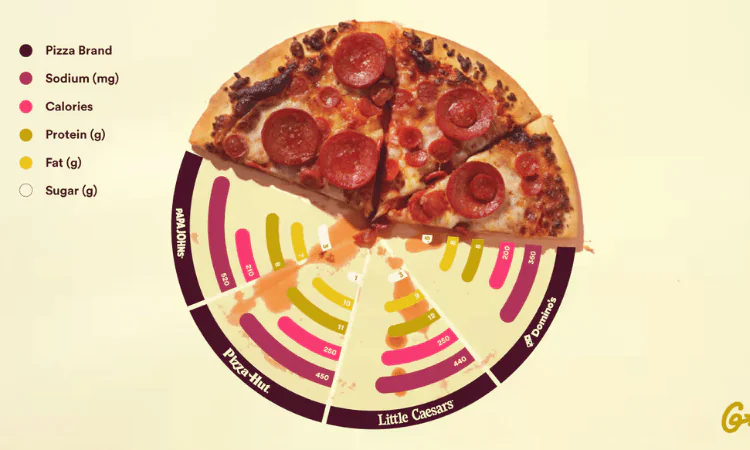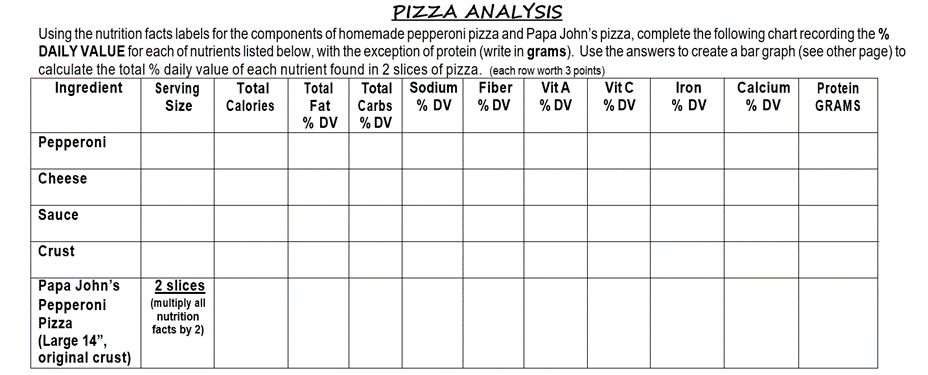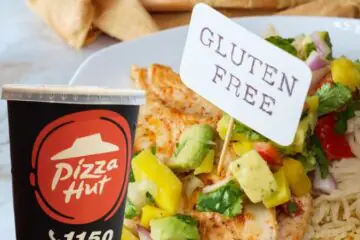The calorie content in homemade pizza versus Papa John’s varies based on ingredients and portion sizes. Homemade pizzas often have fewer calories due to more control over the components used.
Exploring the caloric differences between homemade pizza and those from Papa John’s hinges on an array of factors. Crafting pizza at home allows for a meticulous selection of ingredients, enabling a potentially healthier, lower-calorie pie. Papa John’s pizzas, while consistent in taste and quality, typically incorporate richer toppings and more generous amounts of cheese and oils, which can increase the calorie count.
Controlling portion size at home is also easier, avoiding the oversized slices common in restaurant servings. Nutrition-savvy individuals might tweak their homemade recipes to further reduce calorie intake by using low-fat cheese, lean meats, or a thinner crust. Ultimately, understanding the distinctions in calorie content aligns with mindful eating and can guide pizza enthusiasts in making choices that align with their health goals.
Caloric Content Faceoff: Homemade Vs. Papa John’s Pizza
Welcome to the Caloric Content Faceoff: Homemade vs. Papa John’s Pizza. Deciding between a cozy night in with a homemade pizza or indulging in a Papa John’s might seem simple. But what about the calories? Do homemade pizzas promise fewer calories, or does Papa John’s have a secret to lighter slices? It’s time to put them to the test and see which pizza tips the scales when it comes to caloric content.
Identifying Factors Affecting Calories In Pizza
- Ingredients: Quality and quantity matter.
- Toppings: More toppings mean more calories.
- Size: A larger slice packs more calories.
- Crust: Thin crust has fewer calories than thick.
- Cheese: The type and amount of cheese can vary.
- Sauce: Homemade sauces might be less calorie-dense.
- Preparation: Cooking methods influence calorie count.
Comparing A Standard Slice: Homemade And Papa John’s
Let’s compare a standard slice of homemade pizza with a typical slice from Papa John’s. Look at a table below for a side-by-side comparison.
| Pizza Type | Crust Type | Toppings | Calories per Slice |
|---|---|---|---|
| Homemade | Thin | Cheese and Vegetables | 250-300 |
| Papa John’s | Original | Cheese and Vegetables | 280-350 |
Remember, these numbers are estimates. Each slice varies based on size, toppings, and other factors. Homemade pizzas can have fewer calories because of lighter toppings and thinner crust. In contrast, Papa John’s slices often contain more generous cheese and a thicker base.

Ingredients Breakdown: Where Calories Add Up
Understanding how homemade and Papa John’s pizzas differ in calories begins with an Ingredients Breakdown: Where Calories Add Up. The difference lies within the layers of each delicious slice. From the dough to the toppings, every choice impacts the final calorie count.
Analyze The Calorie Contributors In Pizza Toppings
Toppings vary widely in calorie content. Let’s peel back the layers:
- Meats: High in calories, especially pepperoni and sausage.
- Veggies: Lower in calories, adding nutrition and flavor.
- Extra toppings: More toppings mean more calories. Keep it simple.
Homemade pizzas often use fresher, less processed toppings, which can translate to fewer calories. Papa John’s, however, standardizes toppings, which might pack more calories per slice.
Cheese And Sauce Differences In Calorie Count
The type and amount of cheese and sauce can change calorie counts:
| Ingredient | Homemade | Papa John’s |
|---|---|---|
| Cheese | Varies | Standardized |
| Sauce | Lighter portions | Often richer |
A homemade pizza allows for control over cheese and sauce amounts. This control can help keep calorie counts in check. Papa John’s pizzas, while delicious, have fixed amounts of cheese and sauce, contributing to a higher calorie tally.
Crust Considerations: Thinner Or Thicker?
Choosing between a thin or thick pizza crust changes your calorie count. Whether to enjoy a crunchy, thin base or a fluffy, thick one can be a dilemma, but it affects more than taste. Calories in pizza crust differ widely with thickness. Let’s delve into the details.
Caloric Contrasts In Various Crust Types
Different crusts carry different calorie amounts. Thin crusts usually have fewer calories. They contain less dough, hence less energy. Thick crusts are denser, contributing to a greater calorie intake. This is vital when balancing a diet or counting calories. Consider these points:
- A standard thin crust slice has fewer calories than a thick crust slice.
- Extra toppings and cheese on a thick crust add more calories.
- Choosing a crust partly determines the pizza’s overall caloric content.
Homemade Dough Vs. Papa John’s: More Than Just Thickness
Homemade pizza allows for full control over ingredients, affecting calories. Papa John’s pizza, while consistent in quality, has a set recipe. The caloric difference stems from:
| Ingredient | Homemade | Papa John’s |
|---|---|---|
| Flour Type | Choice varies | Standard |
| Oil/Fat | Adjustable | Predefined |
| Size | Customizable | Standardized |
With homemade pizzas, one adjusts thickness, size, and ingredients, enabling calorie control. In contrast, Papa John’s pizza offers consistency but less flexibility in these aspects.
The Portion Size Paradigm
Understanding the “Portion Size Paradigm” is crucial when comparing homemade pizza to Papa John’s. Portion sizes directly affect the number of calories consumed. Let’s dive into how this impacts your calorie intake and how to manage those portions effectively while still enjoying your slice of pizza.
How Serving Size Impacts Calorie Intake
Serving size determines the calories you eat. A large slice from Papa John’s may have more calories than a small homemade piece. Knowing the size of each serving can help keep calorie intake in check.
Here’s a simple comparison:
| Type of Pizza | Standard Serving Size | Approximate Calories |
|---|---|---|
| Homemade Pizza | 1 Slice (1/8 of a 12″ pizza) | 200 calories |
| Papa John’s Pizza | 1 Slice (1/8 of a 14″ pizza) | 300 calories |
Calorie difference often comes from crust type, toppings, and oils used. Papa John’s may add more cheese, which increases calories.
Managing Portions For Mindful Consumption
Choosing the right portion is key to enjoying pizza without overeating. Here are steps to manage your pizza portions:
- Check serving sizes before eating. Stick to one or two slices.
- Use a kitchen scale or measuring tools to gauge homemade pizza sizes.
- Balance your meal with salads or vegetables to fill up without excessive calories.
- Avoid extras like dipping sauces or sugary drinks that increase total calorie intake.
When it comes to pizza, enjoying your meal mindfully with proper portion control can make all the difference. Keep an eye on serving sizes, and you can have your pizza and eat it too!
Cooking Methods’ Caloric Influence
Cooking methods can greatly influence the calorie content of food. This is particularly true for pizza. Understanding how baking techniques affect calories helps make informed choices between homemade and Papa John’s pizza.
Calorific Impact Of Baking Techniques
Baking pizza at home versus ordering from Papa John’s can display differences in calorie count due to various baking methods.
- Temperature and time can alter the amount of oil absorbed and the dough’s texture, potentially affecting caloric intake.
- A professional oven’s consistent high heat could mean a well-cooked crust, potentially demanding less oil.
- Homemade pizza allows for personal ingredient control, influencing the overall calories.
Does Homemade Pizza’s Cooking Method Save Calories?
The method of cooking homemade pizza can indeed save calories.
- Choosing healthier toppings and low-fat cheese reduces calories.
- Controlling the amount of oil used during baking can decrease fat content.
- Opting for a thinner crust cuts down on dough consumption and hence, calorie intake.
Overall, homemade pizzas can be a lighter option based on cooking method adjustments.
Healthy Alternatives For Pizza Lovers
Exploring healthy pizza alternatives can significantly lower your calorie intake. Crafting a pizza at home allows for more control over ingredients compared to Papa John’s options, often leading to fewer calories and fresher toppings.
As a health-conscious pizza aficionado, you may often wonder about the difference in calories between a slice of homemade pizza and one from Papa John’s. Fear not, pizza lovers! This guide explores healthy alternatives for those looking to enjoy this beloved dish while keeping calorie count in check. Whether whipping up a pizza at home or opting for a Papa John’s treat, there are smart choices to be made for a healthier slice.
Low-calorie Swaps For Your Pizza Recipe
Homemade pizza gives you full control over what goes into your pie. By making a few strategic swaps, you can significantly slash calories without compromising taste. Here are some smart substitutions:
- Use a thin whole wheat crust: Less dough means fewer calories.
- Opt for tomato-based sauces: They’re lighter than creamy ones.
- Go for low-fat cheese: Choose part-skim mozzarella or other lighter options.
- Pile on the veggies: They add flavor and fiber for minimal calories.
- Choose lean proteins: Think grilled chicken or turkey pepperoni.
Papa John’s Menu Options For The Calorie-conscious
Papa John’s also caters to those counting calories. With a menu dedicated to lighter fare, here’s what you can order without the guilt:
| Pizza | Calories per Slice |
|---|---|
| Garden Fresh (Original Medium) | 210 |
| Tropical Luau (Original Medium) | 230 |
| Grilled Chicken & Canadian Bacon (Original Medium) | 220 |
Additional tips for Papa John’s pizza enthusiasts:
- Request a thin crust: Save on dough-derived calories.
- Skip the cheese: Or ask for half the usual amount.
- Focus on veggie toppings: These are lower in calories.
- Avoid high-calorie dips and sauces: Small packets can be calorie bombs.
Whether you’re dining in, ordering out, or crafting your own pizza masterpiece, mindful choices lead to a more satisfying and healthful experience. With these tips, even pizza can be part of a balanced diet. Enjoy every bite, knowing you’ve made smart, lower-calorie decisions!

Frequently Asked Questions For What Is The Difference In Calories Between Homemade And Papa John’s Pizza
How Many Calories In A Homemade Pizza?
The calorie content of a homemade pizza varies, typically ranging from 200 to 300 calories per slice, depending on the toppings and size.
How Many Calories Is Two Slices Of Homemade Pizza?
Two slices of homemade pizza typically contain around 400 to 700 calories, depending on the toppings and crust thickness.
What Part Of A Pizza Has The Most Calories?
The crust typically contains the most calories in a pizza, especially if it’s thick or stuffed with cheese. Toppings like meat and extra cheese also add significant calories.
Is Homemade Pizza Healthier Than Frozen?
Homemade pizza can be healthier than frozen, as you control the ingredients and can use whole, fresh, and less processed foods. Frozen pizzas often contain preservatives and higher sodium levels.
Conclusion
Choosing between homemade and Papa John’s pizza involves more than taste preferences; it’s also about caloric content. Crafting your pie offers control over ingredients and can reduce calories significantly. Papa John’s, while convenient, typically brings a higher calorie count. Prioritize homemade for a lighter option or indulge mindfully with Papa John’s when convenience calls.
Enjoy your pizza journey, balancing flavor with health considerations in mind.

As the author of the “Ultimate Pizza Guide: Recipes, Tips & Secrets Revealed,” I’m dedicated to sharing my love for pizza and empowering others to create delicious homemade pizzas with ease. Join me on a journey to uncover the secrets to perfecting your pizza game!




